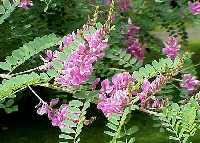|
 1. Cultivation of Indigo (this page) 1. Cultivation of Indigo (this page)
2. Harvesting Indigo dye (this page)
3. Extracting Indigo pigment (opens new page)
4. back to Indigo (opens main Indigo page)
Cultivation of Indigo (Growing Indigo)
Indigo plants love warmth and humidity. To grow indigo in a cold country, you need a warm greenhouse, a conservatory or a sunny windowsill. Providing you can keep the plants warm, the earlier you sow indigo seeds the better, as you will have a longer growing season. I try to sow mine in early February, but you can sow indigo seeds as late as April.
Soak the seeds overnight in water and then sow your seeds in pots at least 3 inches in diameter, one seed per pot (pots are better than seed trays because indigo does not like to have its roots disturbed). Keep the pots in a heated propagator until the seeds germinate and then move them to warm windowsill. When the indigo seedlings are large enough, re-pot them once or twice into larger pots with good soil. Eventually use a 10 litre pot per plant. If you have a sheltered position and the weather is warm you might be able to keep the plants outside in the summer.
Indigo plants are hungry feeders and need feeding almost as often as tomatoes. Well cared for plants can grow 2 metres tall and might need pruning.
Spray the plants with water from time to time and if possible keep them on a pebble tray to increase humidity. Keep checking greenhouse plants for red spider mite, which may be a sign that the humidity is not high enough.
Harvesting Indigo dye
The best time to harvest is just before the flowers open. Indigo is a perennial plant and to keep the plant for more than a year you should harvest only half the leaves at one time.
Your indigo plant may need to be more than a year old to come into bloom and it needs plenty of warmth to flower. Try to keep it alive over the winter which should give you an early start the following year. Do not feed the plants from October to March, prune them to a manageable size, reduce watering and keep the plants warm.
Extracting Indigo Pigment (indigo dye)
Use the leaves as soon after harvesting as you can, and follow the instructions for extracting indigo dye from Japanese Indigo. If you have a large enough pot to soak the indigo you can use chopped branches, otherwise pluck and use the leaves.
According to Buchanan, 500 grams of indigo leaves will give you enough pigment for approximately 100 to 200 grams of wool. This varies with weather, soil and age of the indigo plant.
Top of page
|